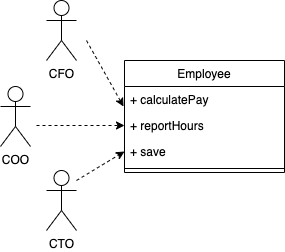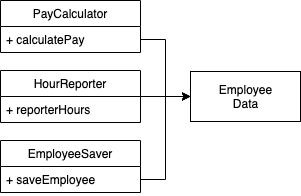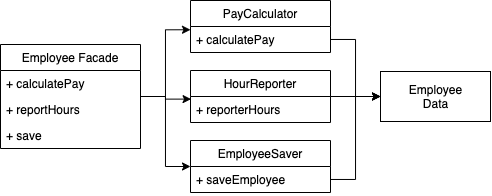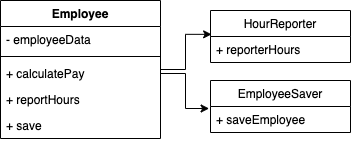SOLID
好的軟體架構始於 clean code。
- 能容忍變化,
- 容易理解,而且
- 是許多軟體系統中能夠使用的元件的基礎。
中層級:定義模組和元件內使用的軟體結構類型
- SRP: 單一職責原則
- OCP: 開放-封閉原則
- LSP: 里氏替換原則
- ISP: 介面隔離原則
- DIP: 依賴反轉原則
Single Responsibility Principle
一個模組應該只對唯一的一個角色負責
模組(Module):
一個原始檔(source file)
症狀 1 : 意外重複

- calculatePay() 方法由會計部指定,並向 CFO 報告。
- reportHours() 方法由人力資源部指定和使用,並向 COO 報告。
- save() 方法由 DBA 指定,並向 CTO 報告。
共用演算法
分開不同角色所依賴的程式碼(separate the code that different actors depend on)
症狀 2 : 合併

分離支援不同角色的程式碼(separate code that supports different actors)
解決方案
避免意外重複(accidental duplication)

三個類別不相互了解

FACADE [fəˈsäd] 模式

Example
- Bad way:
class Book {
public title: string;
public author: string;
public description: string;
public pages: number;
// constructor and other methods
public saveToFile(): void {
// some fs.write method to save book to file
}
}
- Good way:
class Book {
public title: string;
public author: string;
public description: string;
public pages: number;
// constructor and other methods
}
class Persistence {
public saveToFile(book: Book): void {
// some fs.write method to save book to file
}
}
Example 2
- 這個例子,Book Model 符合 SRP 嗎?為什麼?
// MVC Model
class Book extends Model {
constructor() {
this.conn = mysql.createConnection({...});
}
public get() {
const conn = this.conn
return new Promise((resolve, reject) => {
conn.query('SELCT * FROM book', (result, error) => {
if (error) { reject(error) }
resolve(result)
})
})
}
public write(books) {
// ...
}
destructor() {
this.conn.close()
}
}
// MVC Controller
async function controller() {
const bookModel = new Book()
return await bookModel.get()
}
// Background Cronjob
async function updateAuthorJob() {
const bookModel = new Book()
const books = await bookModel.get()
books.map(book => ({...book, author: 'bob'}))
await bookModel.write(books)
}